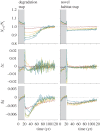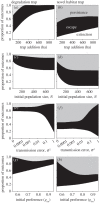How the type of anthropogenic change alters the consequences of ecological traps
- PMID: 22378802
- PMCID: PMC3350704
- DOI: 10.1098/rspb.2012.0139
How the type of anthropogenic change alters the consequences of ecological traps
Abstract
Understanding altered ecological and evolutionary dynamics in novel environments is vital for predicting species responses to rapid environmental change. One fundamental concept relevant to such dynamics is the ecological trap, which arises from rapid anthropogenic change and can facilitate extinction. Ecological traps occur when formerly adaptive habitat preferences become maladaptive because the cues individuals preferentially use in selecting habitats lead to lower fitness than other alternatives. While it has been emphasized that traps can arise from different types of anthropogenic change, the resulting consequences of these different types of traps remain unknown. Using a novel model framework that builds upon the Price equation from evolutionary genetics, we provide the first analysis that contrasts the ecological and evolutionary consequences of ecological traps arising from two general types of perturbations known to trigger traps. Our model suggests that traps arising from degradation of existing habitats are more likely to facilitate extinction than those arising from the addition of novel trap habitat. Importantly, our framework reveals the mechanisms of these outcomes and the substantial scope for persistence via rapid evolution that may buffer many populations from extinction, helping to resolve the paradox of continued persistence of many species in dramatically altered landscapes.
Figures

 ) and habitat preference (
) and habitat preference ( ) over time for two types of ecological traps under different amounts of trap habitat created (ha). Grey shading denotes initial dynamics that occur prior to trap formation. Marginal means from 37 500 simulations are shown for each type of trap. Brown line, 100; orange line, 300; green line, 500; dark green line, 700; blue line, 900.
) over time for two types of ecological traps under different amounts of trap habitat created (ha). Grey shading denotes initial dynamics that occur prior to trap formation. Marginal means from 37 500 simulations are shown for each type of trap. Brown line, 100; orange line, 300; green line, 500; dark green line, 700; blue line, 900.

Similar articles
-
A framework for understanding ecological traps and an evaluation of existing evidence.Ecology. 2006 May;87(5):1075-85. doi: 10.1890/0012-9658(2006)87[1075:affuet]2.0.co;2. Ecology. 2006. PMID: 16761584 Review.
-
Impacts of human-induced environmental change in wetlands on aquatic animals.Biol Rev Camb Philos Soc. 2018 Feb;93(1):529-554. doi: 10.1111/brv.12358. Epub 2017 Sep 19. Biol Rev Camb Philos Soc. 2018. PMID: 28929570 Review.
-
Evaluating the metapopulation consequences of ecological traps.Proc Biol Sci. 2015 Apr 7;282(1804):20142930. doi: 10.1098/rspb.2014.2930. Proc Biol Sci. 2015. PMID: 25761712 Free PMC article.
-
Virus population extinction via ecological traps.Ecol Lett. 2007 Mar;10(3):230-40. doi: 10.1111/j.1461-0248.2006.01013.x. Ecol Lett. 2007. PMID: 17305806
-
Ecological novelty and the emergence of evolutionary traps.Trends Ecol Evol. 2013 Sep;28(9):552-60. doi: 10.1016/j.tree.2013.04.004. Epub 2013 Jun 5. Trends Ecol Evol. 2013. PMID: 23756104 Review.
Cited by
-
Discovery and exploitation of a natural ecological trap for a mosquito disease vector.Proc Biol Sci. 2018 Nov 21;285(1891):20181962. doi: 10.1098/rspb.2018.1962. Proc Biol Sci. 2018. PMID: 30464065 Free PMC article.
-
Ecological traps: current evidence and future directions.Proc Biol Sci. 2016 Feb 10;283(1824):20152647. doi: 10.1098/rspb.2015.2647. Proc Biol Sci. 2016. PMID: 26865295 Free PMC article. Review.
-
Experimental Test of Preferences for an Invasive Prey by an Endangered Predator: Implications for Conservation.PLoS One. 2016 Nov 9;11(11):e0165427. doi: 10.1371/journal.pone.0165427. eCollection 2016. PLoS One. 2016. PMID: 27829031 Free PMC article.
-
Habitat Heterogeneity Variably Influences Habitat Selection by Wild Herbivores in a Semi-Arid Tropical Savanna Ecosystem.PLoS One. 2016 Sep 28;11(9):e0163084. doi: 10.1371/journal.pone.0163084. eCollection 2016. PLoS One. 2016. PMID: 27680673 Free PMC article.
-
Transgenerational Plasticity in Human-Altered Environments.Trends Ecol Evol. 2020 Feb;35(2):115-124. doi: 10.1016/j.tree.2019.09.003. Epub 2019 Nov 6. Trends Ecol Evol. 2020. PMID: 31706627 Free PMC article. Review.
References
-
- Cheptou P. O., Carrue O., Rouifed S., Cantarel A. 2008. Rapid evolution of seed dispersal in an urban environment in the weed Crepis sancta. Proc. Natl Acad. Sci. USA 105, 3796–379910.1073/pnas.0708446105 (doi:10.1073/pnas.0708446105) - DOI - DOI - PMC - PubMed
-
- Stockwell C. A., Hendry A. P., Kinnison M. T. 2003. Contemporary evolution meets conservation biology. Trends Ecol. Evol. 18, 94–10110.1016/S0169-5347(02)00044-7 (doi:10.1016/S0169-5347(02)00044-7) - DOI - DOI
-
- Reeve H. K., Sherman P. W. 1993. Adaptation and the goals of evolutionary research. Quart. Rev. Biol. 68, 1–3210.1111/j.1469-185X.1993.tb00731.x (doi:10.1111/j.1469-185X.1993.tb00731.x) - DOI - DOI
-
- Crespi B. J. 2000. The evolution of maladaptation. Heredity 84, 623–62910.1046/j.1365-2540.2000.00746.x (doi:10.1046/j.1365-2540.2000.00746.x) - DOI - DOI - PubMed
-
- Schlaepfer M. A., Runge M. C., Sherman P. W. 2002. Ecological and evolutionary traps. Trends Ecol. Evol. 17, 474–48010.1016/S0169-5347(02)02580-6 (doi:10.1016/S0169-5347(02)02580-6) - DOI - DOI
Publication types
MeSH terms
LinkOut - more resources
Full Text Sources

